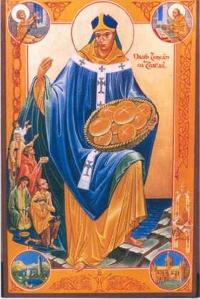
Feast day: 14 November
St Laurence O’Toole was born at Castledermot, Co. Kildare, in the year 1128. His father, Maurice O’Toole, was King of Hy Murray, and was often engaged in warfare with the McMurroughs. When he was ten Laurence was given as a hostage to Dermot McMurrough, King of Leinster. It was a common practice at that time for princes of one clan to be given as hostages to another to ensure peace. At first he was treated as one of the family but when Maurice, his father, was suspected of treachery the boy was sent far away. He was lodged in a herdsman’s hut, where he had very little to eat and not enough clothes to keeo him warm. Eventually the Abbot of Glendalough mediated between the two families and Laurence was given shelter at Glendalough. Here he found solace in the monastic life and he became a monk. At the age of twenty-five he was elected abbot unanimously. During his regime learning was encouraged and the poor were looked after. No doubt his own experience made him sympathetic to those in need. When there was a famine he even sold some of the treasures of Glendalough to provide food for the hungry.
in 1162, at the age of 32, he was appointed the first Irish-born archbishop of the Danish-governed city of Dublin. Laurence set about renewal in his diocese, where many people had ceased to practise their religion. He himself lived a holy life. He brought Augustinian canons from France and they lived at Christchurch Cathedral. Laurence shared their life, joining them for singing of Divine Office and eating with them. He never ate meat, he wore a hair shirt and fasted on Fridays taking only bread and water. In Lent he would return to Glendalough to spend forty days in St Kevin’s cave.
He attended the Third Lateran Council of the church in Rome in 1179 with some of the other Irish bishops. Laurence was entrusted with the reform of the Irish church by the Pope Alexander III.
As archbishop of Dublin he inevitably became involved in the politics of the time. The Normans under Strongbow, Earl of Clare, had invaded Ireland in 1169 at the request of Dermot McMurrough who had fled to England as a result of his feud with the Gaelic chieftains. Dermot McMurrough was married to Laurence’s sister. Dermot enlisted Norman help to regain his kingdom of Leinster. Laurence tried to make peace but during the talks, the Normans attacked and many people were killed. Laurence visited England several times in an effort to bring about peace, frequently travelling in stormy conditions. He was one of the signatories of the Treaty of Windsor in 1175 between England’s Henry II and Ireland’s High King Rory O’Connor.
In 1180 another dispute broke out between Henry and the Irish kings. Once more Laurence travelled to England. This time Henry, embroiled in his conflct with Thomas a Becket, refused to see him in England and Laurence was forced to follow him to France where Henry was Duke of Normndy. The King was anxious to remove Laurence as Archbishop of Dublin and would not allow him to return to Ireland.
Laurence became seriously ill and was cared for by the monks at Eu in Normandy. On 14 November 1180 he died at the age of 52. His tomb is in the crypt, under the collegiate church at Eu. His life was written by a contemporary there. A French seaport was named after him and a gothic church at Eu was dedicated to him. In 1442 a nobleman who had fought at Agincourt brought St Laurence’s skull to England and it was buried at Chorley, though it disappeared at the time of the Reformation. His Heart was preserved in Christchurch Cathedral Dublin (from where it was stolen in 2012).
St Laurence O’Toole, pray for us.